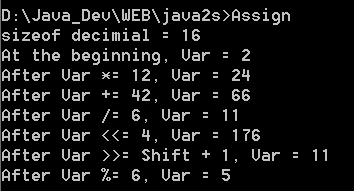Demonstrates compound assignment operators

/*
C# Programming Tips & Techniques
by Charles Wright, Kris Jamsa
Publisher: Osborne/McGraw-Hill (December 28, 2001)
ISBN: 0072193794
*/
//
// Assign.cs - Demonstrates compound assignment operators
//
// Compile this program with the following command line:
// C:>csc Assign.cs
//
namespace nsAssignment
{
using System;
public class Assign
{
static public void Main ()
{
unsafe
{
int x = sizeof (decimal);
Console.WriteLine ("sizeof decimial = " + x);
}
//
// Start with an integer variable
int Var = 2;
//
// Show the starting value
Console.WriteLine ("At the beginning, Var = {0}", Var);
//
// Multiply the variable by something
Var *= 12;
Console.WriteLine ("After Var *= 12, Var = {0}", Var);
//
// Add something to the variable
Var += 42;
Console.WriteLine ("After Var += 42, Var = {0}", Var);
//
// Divide the variable by something
Var /= 6;
Console.WriteLine ("After Var /= 6, Var = {0}", Var);
//
// Shift the bits in the variable four spaces to the left
// This is the same as multiplying by 16 (2 to the fourth power)
Var <<= 4;
Console.WriteLine ("After Var <<= 4, Var = {0}", Var);
//
// Shift the bits in the variable four spaces to the right using
// and expression on the right. This is the same as dividing
// by 16.
int Shift = 3;
Var >>= Shift + 1;
Console.WriteLine ("After Var >>= Shift + 1, Var = {0}", Var);
//
// Modulo divide the variable by something
Var %= 6;
Console.WriteLine ("After Var %= 6, Var = {0}", Var);
}
}
}
Related examples in the same category